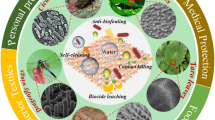Abstract
Polyvinyl alcohol/carboxymethylcellulose/silver sulfadiazine composite nanofibers (PVA/CMC/SSD) containing different proportions of each ingredient were prepared by electrospinning and characterized by Fourier-transform infrared spectroscopy (FTIR), scanning electron microscopy (SEM), thermo-gravimetric analysis (TGA), powder X-ray diffraction analysis (XRD), atomic absorption spectroscopy (AAS), and ultraviolet-visible (UV-Vis) spectroscopy. The obtained nanofibers were uni-axially formed with randomly oriented longitudinal axes without entanglement, and their mean diameters ranged from 160 to 210 ran. Silver sulfadiazine, on the other hand, was appeared as a non-uniform dispersion of spherical nanoparticles ranging from 35 to 75 nm over the surface of nanofibers. Efficacy of the silver sulfadiazine loaded nanofibers for treatment of wounds caused be excision in rabbits in a period of 14 days was evaluated and it was found that the extent of skin repair in the applied dressing depends on the total Ag content. The dressing composed of 73.6:24.6:1.8 weight percent of PVA/CMC/SSD provided the best result in comparison with a control dressing made form PVA/CMC (88.8:11.2 %). In vitro cell viability of fibers on HSF-PI 18 fibroblast like cells was assessed by MTT assay. Antibacterial activity of the prepared nanofibers was also evaluated against gram-negative Escherichia coli and Pseudomonas aeroginosa, and gram-positive Staphylococcus aureus. PVA/CMC/SSD samples, was shown to have significant inhibition effect in comparison with drug references including penicillin G, chloramphenicol and erythromycin as positive controls (P0.05).
Similar content being viewed by others
References
K. P. Rajesh and T. S. Natarakan, J. Nanosci. Nanotechnol, 9, 5402 (2009).
E. J. Chong, T. T. Phan, I. J. Lim, Y. Z. Zhang, B. H. Bay, S. Ramakrishna, and C. T. Lim, Acta Biomaterialia, 3, 321 (2007).
F. Babaeijandaghi, I. Shabani, E. Seyedjafari, Z. S. Naraghi, M. Vasei, V. Haddadi-Asl, K. K. Hesari, and M. Soleimani, Tissue Eng. Part A, 16, 3527 (2010).
J. S. Park, J. W. Park, and E. Ruckenstein, Polymer, 42, 4271 (2001).
M. G. Cascone, S. Maltinti, and N. Barbani, J. Mater. Sci: Mater. Med, 10, 431 (1999).
M. H. El-Newehy, M. E. El-Naggar, S. Alotaiby, H. El-Hamshary, M. Moydeen, and S. Al-Deyab, J. Macromol. Sci, Part A, 53, 566 (2016).
A. R. Unnithan, G. Gnanasekaran, Y. Sathishkumar, Y. S. Lee, and E. Kim, Carbohydr. Polym., 102, 884 (2014).
C. B. Huang, S. J. Soenen, J. Rejman, J. Trekker, C. K. Liu, L. Lagae, W. Ceelen, and C. Wilhelm, Adv. Fund. Mater., 22, 2479 (2012).
D. N. Heo, D. H. Yang, J. B. Lee, M. S. Bae, J. H. Kim, S. H. Moon, H. J. Chun, C. H. Kim, H.-N. Lim, and I. K. Kwon, J. Biomed. Nanotechnol., 9, 511 (2013).
N. M. Morsi, G. A. Abdelbary, and M. A. Ahmed, Eur. J. Pharm. Biopharm., 86, 187 (2013).
S. J. Lee, D. N. Heo, J.-H. Moon, H. N. Park, W.-K. Ko, M. S. Bae, J. B. Lee, S. W. Park, E.-C. Kim, and C. H. Lee, J. Nanosci. Nanotechnol, 14, 7488 (2014).
S. Ullah, M. Hashemi, M. Q. Khan, and D. D. Kharaghani, Y. Saito, T. Yamamoto, and L. S. Kim, RSC Adv., 9, 268 (2019).
R. Warriner and R. Burrell, Advance Skin Wound Care, 18, 2 (2005).
K. Dunn and V. Edwards-Jones, Burns, 30, 2004 (2004).
Y. Kuroyanagi, E. Kim, and N. Shioya, J. Burn Care Rehabil, 12, 106 (1991).
D. Gao, X. Zhou, Z. Gao, X. Shi, Z. Wang, Y. Wang, and P. Zhang, J. Pharm. Sci., 53, 2377 (2018).
F. Gökmeşe, İ, Uslu, and A. Aytimur, Polym. Plast. Technol. Eng., 52, 1259 (2013).
M. Eid, M. El-Arnaouty, M. Salah, E.-S. Soliman, and E.-S. A. Hegazy, J. Polym. Res., 19, 9835 (2012).
K. Shalumon, N. Binulal, N. Selvamurugan, S. Nair, D. Menon, T. Furuike, H. Tamura, and R. Jayakumar, Carbohydr. Polym., 77, 863 (2009).
T. Saito and A. Isogai, Carbohydr. Polym., 61, 183 (2005).
Z. Cao, X. Sun, Y. Sun, and H. Fong, J. Bioact. Compat. Polym., 24, 350 (2009).
S. J. Kim, S. J. Park, K. H. An, N. G. Kim, and S. I. Kim, J. Appl. Polym. Sci., 89, 24 (2003).
C. Dwivedi, H. Pandey, A. C. Pandey, and P. W. Ramteke, Int. J. Pharma Sci. Res., 4, 2224 (2013).
B. B. Mandai, B. Ghosh, and S. C. Kundu, Int. J. Biol. Macromol., 49, 125 (2011).
Y. Li, L. Gui, P. Lin, C. Fan, and Y. Song, Carbohydr. Polyw., 81, 484 (2110).
S. Jangra, S. Devi, V. K. Tomer, V. Chhokar, and S. Duhan, J. Asian Ceramic Soc., 4, 282 (2016).
Acknowledgments
Partial support of this study by the research council of University of Guilan is gratefully acknowledged.
Author information
Authors and Affiliations
Corresponding authors
Electronic supplementary material
Rights and permissions
About this article
Cite this article
Alipour, R., Khorshidi, A., Shojaei, A.F. et al. Silver Sulfadiazine-loaded PVA/CMC Nanofibers for the Treatment of Wounds Caused by Excision. Fibers Polym 20, 2461–2469 (2019). https://doi.org/10.1007/s12221-019-9314-0
Received:
Revised:
Accepted:
Published:
Issue Date:
DOI: https://doi.org/10.1007/s12221-019-9314-0




